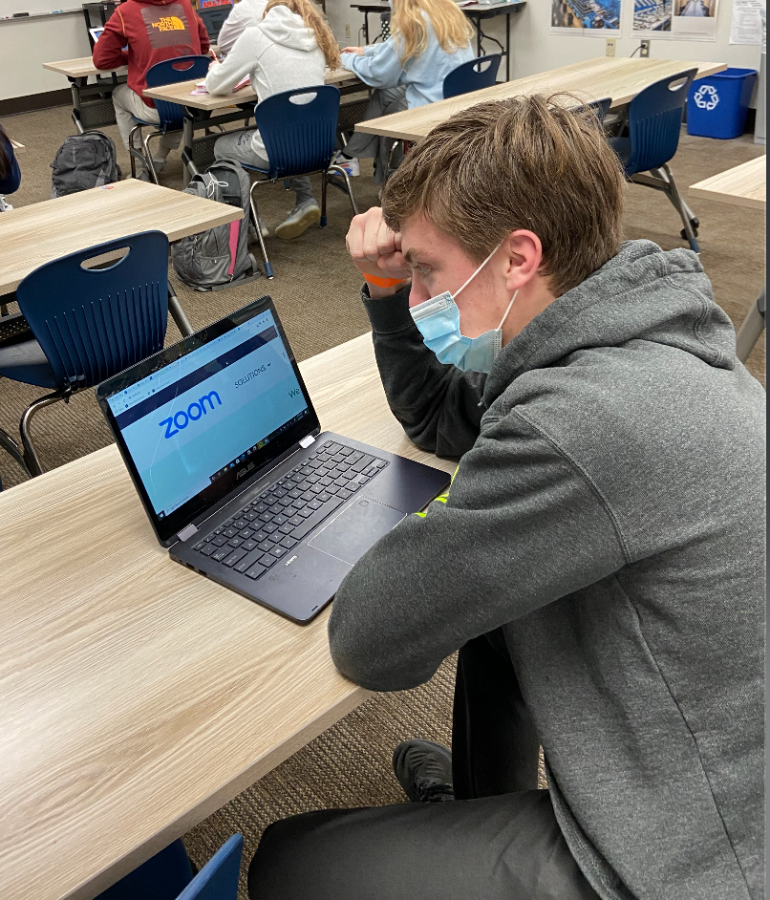Students struggle to pay attention on Zoom
Junior Kevin Petersen demonstrates the apathy and frustration that he and most of his high school classmates encounter as a result of having to attend school on Zoom.
February 18, 2021
A year ago, most of us had never heard of Zoom. Now, we can’t imagine our lives without the video communications app, especially in the world of education. Battling Covid and quarantines is our new reality this school year, so we rely on Zoom to attend classes when we can’t physically be there in person.
From a student perspective, though, that’s about where the benefits of Zoom end.
For most students, Zooming is just a time to start bad habits like sleeping, wearing whatever out of uniform clothing you want, and taking out your phone in the middle of class.
For example, “I don’t eat breakfast anymore because I wake up right before my Zoom,” senior Hudson Feldman said. “It messes up my energy for the day.”
It’s not just St. Pius X students who find themselves in situations like this. According to The New York Times, 65% of students who learn school virtually via Zoom are more likely to develop habits that will negatively affect their future.
Another disadvantage of Zoom is that it’s just plain awkward, especially when you have to talk. In the pre-pandemic era at school, quieter students could keep to themselves and blend in with the class while their more talkative peers did most of the participation.
On Zoom, though, there’s no hiding. Your square is the same size as everyone else’s, and you quickly can become the main focal point of class at any moment, especially if you find yourself losing focus. The teachers can often notice this, so they’ll call you out in class and ask you a question. Sometimes they don’t even respond (maybe they’re just praying the teacher will move on), or if they do they’ll say, “Can you repeat the question?” or “Sorry, I wasn’t listening.” Some of the bolder students will even have enough guts to say, “Sorry you cut out I couldn’t hear you can you repeat that?”
The real awkwardness, though, is when everyone is sitting in silence just staring at the teacher. Spontaneous comments now require you to unmute yourself and cross your fingers that you don’t start talking at the same time as someone else. It’s clunky and tiresome to simply have a discussion with your classmates.
Learning through Zoom is also more difficult because the teacher often doesn’t realize how things look and sound from a student perspective at home.
“I find it very awkward and hard to learn on Zoom as most teachers set up their cameras and microphones and then move away from their computers to get in front of the class so that they can teach the other students,” junior Jack Kelly said. “This is when I start to lose focus because I am no longer able to hear the teacher as well, and they can’t see me, so I feel like it gives me more of an urge to go on my phone or do something that I am not supposed to do.”
Senior Zani Patasin agreed.
“When I am Zooming, I pay attention for about five minutes then go on my phone or make a sandwich or some food,” he said.
He went on to add that he’s been quarantined twice this school year and that “it is almost like I get two weeks off school because I feel as if I never get anything productive done.”
Junior Margaret Muir struggles with Zoom classes as well.
“Every day when I log onto PSL and click the Zoom link, I know it’s going to be like every other day,” she said. “I don’t really like being virtual and looking at a screen for seven hours a day.”
Being in an uncomfortable educational environment makes learning difficult and not nearly as effective. It’s too easy for students to form bad habits while left in their bedrooms all day, natural conversation is stifled, and the overall result is frustrating for the student and the teacher at times.
Sure, there are plenty of small things we can do to help make the best of a situation we can’t control, but no matter how hard any of us try, Zooms will always be awkward.






